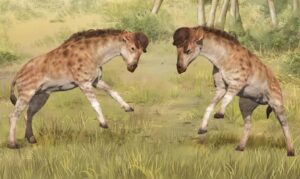JUNE 3, 2022

More than 16 million years ago, giraffes had more compact necks and strange keratinized heads, as seen by newly discovered fossils of Discokeryx xiezhi.
A headbutt is not just a move for Pokemon or legendary soccer players: It’s a clue to the past life of giraffes. A new study published Thursday in the journal Science details an expedition in Northern China where paleontologists uncovered fossils of short-necked giraffes (or girrafoids, the prehistoric version of the modern-day mammals) that liked to bash each other with their skulls.
The relative is called Discokeryx xiezhi, and they had very short necks. Fully grown individuals today have roughly 6-feet-long necks for swinging around and challenging other giraffes to establish dominance (see video below). But the new findings suggest “necking” may be a more recent evolutionary adaption to fighting.
The international team led by Shi-Qi Wang from the Chinese Academy of Sciences in Beijing analyzed the unique structure of the fossils’ headgear and neck joints. They also studied isotope data from preserved tooth enamel that painted a picture of what life was like for the giraffes at the time. The researchers predict the short-necked ancestors lived in the Miocene epoch (a time when grasslands became more abundant) about 16.9 million years ago. The ancient girrafoids spent most of their time roaming open land and likely munched on plant leaves near the ground rather than on top of trees.
As if finding a miniature giraffe species wasn’t enough, the researchers discovered a unique bone structure in the male Discokeryx xiezhi’s head and neck. The joints showed the creatures had a thickened vertebrae and skullcap with a hard layer of keratin similar to those seen in modern bulls and rams. Their helmet-shaped heads were ready to both give and receive a bump to the noggin.
Ultimately, the team concluded that the reinforced skull was likely a sexual weapon, used to head bash other males in competition for mates.
“It shows that giraffe evolution is not just elongating the neck,” study coauthor Jin Meng, a paleontologist at the American Museum of Natural History, told the New York Times. “Discokeryx goes in a totally different direction.”
The results also provide an alternative explanation for how present-day giraffes developed their long necks. The prevailing theory is that competition for food was the primary driver behind neck elongation, allowing them to access leaves in the canopy. But sexual competition may have favored head-bashing girrafoids with slightly longer necks. As individuals of the species used more of their necks in fighting, it gave them the opportunity to breed longer-necked offspring with the unintended benefit of being tall enough to reach for food on top of trees.
“At present, it is not easy to distinguish the ‘feeding competition’ hypothesis from the ‘necks for sex’ idea,” Robert Simmons, an honorary research associate at the University of Cape Town’s FitzPatrick Institute of African Ornithology who was not involved in the study, told Live Science. “It is very likely that both have played a role in the evolution of the magnificent animals we see today.
Courtesy/Source: Popular Science










































































































